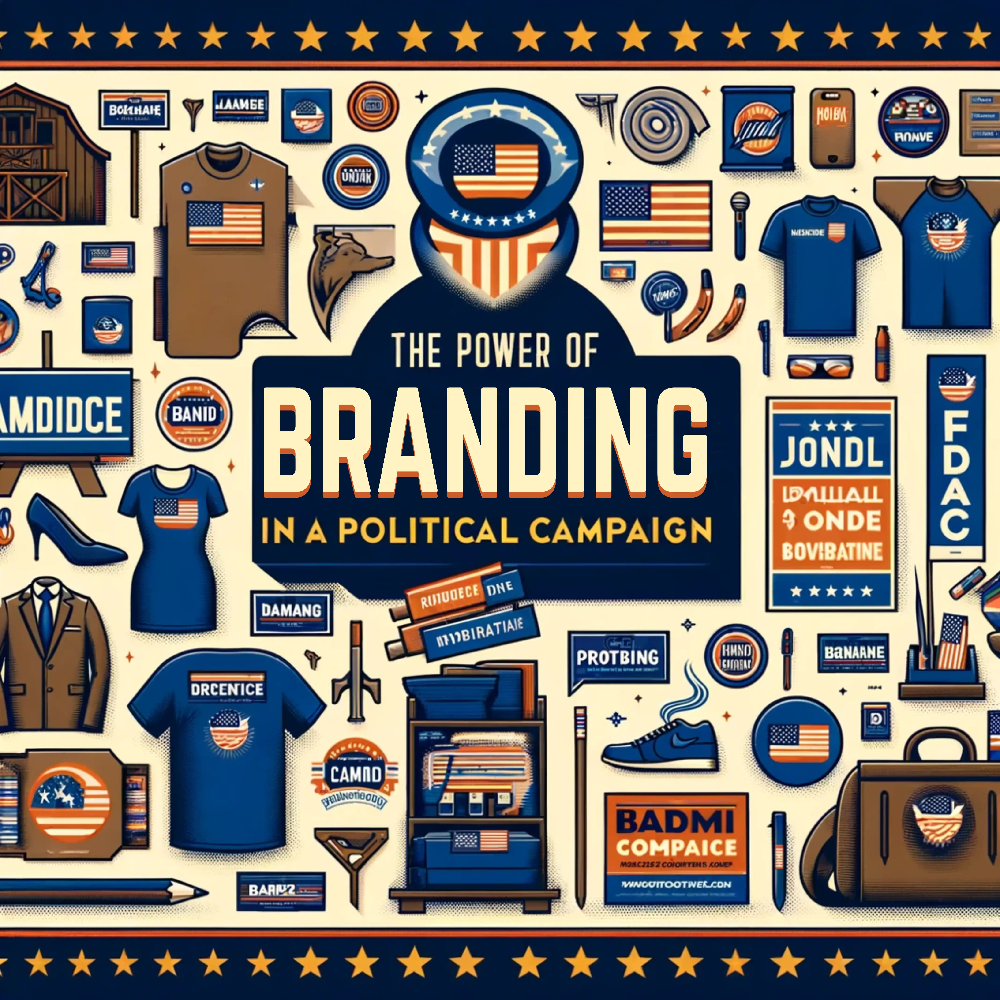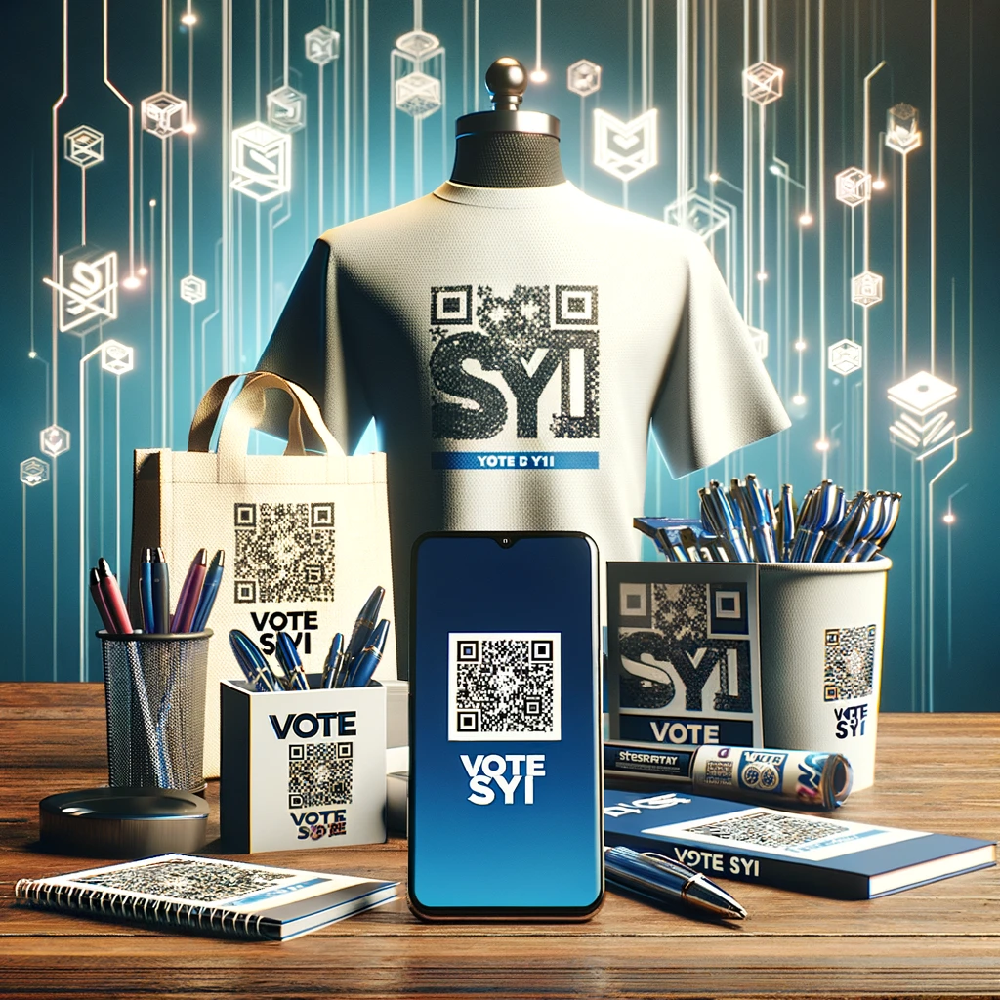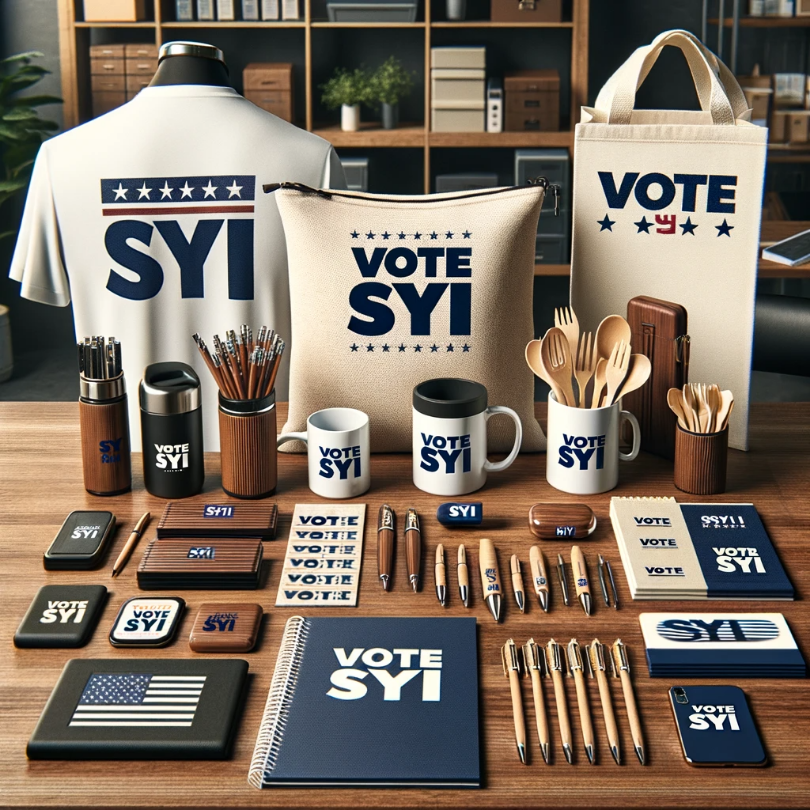In the world of political campaigns, the battle for attention and support is fierce. Deeply immersed in the e-commerce promotional products industry, we've seen firsthand the transformative impact of well-chosen promotional items in political campaigns. Here's a guide on how to effectively market a political campaign using promotional products.
Understanding Your Audience
|
First and foremost, know your audience. Political campaigns are about connecting with people, and your promotional items should reflect the interests and values of your target demographic. Whether it’s the youth vote you’re after or the senior citizens, choose items that resonate with them. Understanding your audience is a fundamental aspect of any successful political campaign. It's about much more than just knowing who the voters are; it's about comprehending their needs, interests, values, and the issues that resonate most with them. This understanding is crucial when selecting and designing promotional items for your campaign. Here’s a detailed look into this process: - Demographic Analysis: Start with a thorough analysis of the demographics of your target audience. Look into age, gender, location, economic status, educational background, and cultural influences. This data helps in tailoring your campaign to address the specific needs and interests of different groups.
- Youth Voters: If targeting younger voters, for instance, focus on issues like education, employment opportunities, and climate change. Choose promotional items that appeal to a younger demographic, such as eco-friendly products, trendy apparel, or tech accessories.
- Senior Citizens: For senior citizens, healthcare, social security, and community issues might be more relevant. Promotional items like customized calendars, health-related products, or branded household items might be more appealing.
- Value Alignment: Every promotional item should reflect the values and promises of your candidate. This alignment helps in building trust and credibility with your audience.
- Ethical Sourcing: Consider the ethical sourcing of your promotional items. This is particularly important if your campaign emphasizes environmental responsibility or social justice.
- Engagement and Interaction: Use promotional items to create opportunities for engagement and interaction. Items that encourage participation, like branded sign-up forms or QR codes linking to online platforms, can be effective in increasing voter engagement.
- Cultural Sensitivity: Be mindful of cultural sensitivities and ensure that your promotional items are respectful and inclusive. This is crucial in a diverse electorate where cultural nuances can significantly impact the perception of your campaign.
- Feedback Loop: Establish a feedback loop to understand how your audience perceives the promotional items. Use surveys, social media engagement, and direct feedback at events to gauge the effectiveness of your items.
- Flexibility and Adaptation: Be prepared to adapt your strategy based on audience response. If certain items are not resonating as expected, be ready to make changes.
- Storytelling Through Items: Use your promotional items to tell a story about your candidate and campaign. Every item should contribute to the narrative you want to convey to your audience.
- Utilizing Data: In today’s digital age, make use of data analytics to understand audience preferences and trends. This can help in making informed decisions about the type of promotional items to invest in.
In conclusion, understanding your audience in a political campaign involves a blend of demographic research, value alignment, cultural sensitivity, and continuous engagement. By choosing promotional items that resonate with your target demographic and reflect the core message of your campaign, you can create a deeper and more meaningful connection with your audience. |
The Power of BrandingYour candidate's brand is crucial. It's not just a logo or a color scheme; it's a representation of their values and promises. Use promotional products to reinforce this brand. From apparel to yard signs, every item should reflect the candidate’s message and ethos. |  |
The power of branding in a political campaign cannot be overstated. It is an essential tool in creating a distinct identity for your candidate and in communicating the core values and promises of their campaign to the electorate. A well-crafted brand transcends mere visuals like logos and color schemes; it encapsulates the essence of the candidate's message and ethos. Here's an in-depth look at the role of branding in political campaigns and how promotional products can be utilized to reinforce this brand: - Branding as Storytelling: At its core, branding is a form of storytelling. It's about crafting a narrative that resonates with voters, one that communicates who the candidate is, what they stand for, and what they promise to achieve. This narrative should be consistent across all campaign materials and messaging, creating a cohesive and recognizable brand identity.
- Consistency Across Platforms: Consistency is key in branding. The candidate’s logo, color scheme, and messaging should be uniform across all platforms - from digital media like websites and social media to traditional materials like flyers, posters, and yard signs. This consistency helps in building recognition and trust among the electorate.
- Emotional Connection: Effective branding establishes an emotional connection with voters. It should evoke feelings of trust, hope, and belief in the candidate’s vision. Promotional products play a crucial role in this by turning abstract political messages into tangible items that voters can interact with.
- Selection of Promotional Products: When choosing promotional products, it’s important to select items that reflect the candidate's message and appeal to the target demographic. For example, if environmental conservation is a key message, eco-friendly products like reusable bags or bamboo utensils can be powerful symbols of this commitment.
- Visibility and Recall: Branded promotional products increase the visibility of the campaign. Items like apparel, yard signs, and bumper stickers turn supporters into walking billboards for the candidate. This not only boosts the campaign’s presence in the public sphere but also aids in recall during voting.
- Customization for Different Audiences: Customize promotional items for different segments of the electorate. For instance, younger voters might appreciate branded tech gadgets, while older voters might find more value in practical items like branded pill organizers or calendars.
- Quality Matters: The quality of promotional products reflects on the candidate’s brand. High-quality items convey a message of professionalism and attention to detail, while poor-quality items might negatively impact the campaign’s image.
- Legal and Ethical Considerations: Ensure that the branding and distribution of promotional products comply with all legal and ethical standards. This includes adhering to campaign finance laws and ensuring that the manufacturing of these items aligns with ethical practices.
In essence, branding in a political campaign is about creating a memorable and impactful identity that captures the candidate’s vision and values. Promotional products are a vital tool in this process, offering a direct and personal way to communicate the campaign’s message and solidify the candidate's presence in the minds of voters. By thoughtfully leveraging the power of branding through these items, a campaign can significantly enhance its reach and effectiveness. |
Integration with Digital MarketingCombine traditional promotional methods with digital strategies. QR codes on promotional items can direct users to your campaign website or a donation page. Social media contests with promotional products as prizes can increase online engagement and spread your message further. |  |
Integrating digital marketing strategies with traditional promotional methods is a dynamic way to enhance the effectiveness of a political campaign. This fusion not only broadens the reach but also adds a layer of interactivity and engagement that is essential in today's digital landscape. Let's delve into how this can be accomplished effectively: - Utilizing QR Codes: QR codes are a simple yet powerful tool for bridging physical promotional products and digital platforms. When placed on items like t-shirts, hats, or flyers, these codes can instantly direct supporters to a campaign website, donation page, or digital registration form. This seamless transition from physical to digital interaction not only simplifies the user experience but also encourages immediate action.
- Trackable Links: Use unique, trackable links in your QR codes. This allows you to monitor the effectiveness of different products in driving traffic to your digital assets.
- Dynamic Content: Link QR codes to dynamic content like campaign videos, candidate profiles, or real-time campaign updates. This keeps the content fresh and engaging.
- Social Media Integration: Social media platforms are fertile ground for expanding the reach of your campaign's promotional products.
- Contests and Giveaways: Run contests on platforms like Facebook, Twitter, and Instagram where participants can win promotional items. Encourage actions like sharing, tagging friends, or using specific hashtags to enter. This not only increases engagement but also leverages the networks of your supporters to spread your message further.
- User-Generated Content: Encourage supporters to post pictures or stories with your promotional items. This can create a sense of community and amplify your campaign through organic, peer-to-peer marketing.
- Email Marketing with a Twist: Incorporate promotional items into your email marketing campaigns. For instance, offer a branded item as a thank-you for signing up for a newsletter or making a small donation. This approach adds a tangible aspect to what is traditionally a digital-only interaction.
- Digital Advertisements Featuring Promotional Products: Use images or videos of your promotional items in digital ads. This creates a visual connection between your online presence and the physical aspects of your campaign.
- Virtual Events with Physical Swag: In the era of virtual rallies and webinars, sending promotional items to registered attendees beforehand can create a more immersive and engaging experience.
- Data-Driven Personalization: Use data collected from digital interactions to personalize the promotional products you offer. For example, if analytics show that a particular demographic is more engaged online, consider developing promotional items that specifically appeal to that group.
In conclusion, integrating digital marketing with traditional promotional methods creates a multifaceted campaign strategy. It not only enhances the reach and engagement of your campaign but also provides valuable data and insights for further optimization. This approach represents a forward-thinking blend of technology and traditional campaigning, vital for success in the modern political landscape. |
 | Distribution StrategyDistribution is key. Hand out items at rallies, town halls, and other events where you can engage directly with voters. But don't overlook the power of community influencers. Equip local supporters with extra items to share within their networks. |
A well-planned distribution strategy for promotional products is crucial in a political campaign, as it directly impacts the visibility and reach of the campaign's message. Here's a detailed look at effective distribution tactics: - Rallies and Public Events: Utilize rallies, town halls, and other public events as primary distribution points. These events are ideal for handing out promotional items because they attract supporters who are already interested in your campaign.
- Strategic Placement: Set up booths or distribution points at entrances and exits to ensure maximum visibility.
- Variety of Products: Offer a range of items at these events, from wearable merchandise like t-shirts and hats to practical items like buttons, stickers, and flyers.
- Community Involvement: Engage with local community groups and organizations. These groups often have a deep connection with the local populace and can help distribute your promotional materials more effectively within specific communities.
- Partner with Local Businesses: Collaborate with local businesses to distribute your promotional items. This could include leaving items at checkout counters or in high-traffic areas.
- Local Events and Festivals: Participate in local community events and festivals where you can set up a booth or sponsor parts of the event with your promotional materials.
- Utilize Community Influencers: Identify and collaborate with community influencers who can help amplify your campaign's reach. This could include local celebrities, prominent community figures, or respected local leaders.
- Equip with Extra Items: Provide these influencers with extra promotional items to distribute within their networks.
- Leverage Social Media: Encourage influencers to use their social media platforms to showcase your promotional items, further extending your campaign’s reach.
- Door-to-Door Campaigning: Incorporate promotional items into door-to-door campaigning. Volunteers can hand out small items like brochures, stickers, or badges as they interact with voters, making these interactions more memorable.
- Direct Mail Campaigns: Use direct mail campaigns to distribute promotional items to a broader audience. This can be particularly effective for targeting specific demographics or areas where your campaign needs more visibility.
- Online Distribution: Offer promotional items through your campaign’s website or social media channels. This can include giveaways or items as rewards for donations, encouraging online engagement and support.
- Tailoring to Audience: Tailor the type of promotional items distributed based on the event and audience. For instance, use more formal items like branded pens or notebooks for town hall meetings, and more casual items like t-shirts or caps for rallies.
- Monitoring and Adjusting Strategy: Continuously monitor the effectiveness of different distribution channels and adjust your strategy accordingly. Gather feedback from recipients and volunteers to understand which items are most popular and which distribution methods are most effective.
In summary, a diverse and dynamic distribution strategy that encompasses a mix of public events, community engagement, influencer collaboration, and both physical and digital channels can significantly enhance the reach and impact of your political campaign’s promotional products. This approach ensures that your campaign message is disseminated widely and effectively, engaging voters across various platforms and settings. |
Measure the ImpactTrack the effectiveness of your promotional products. Use surveys or digital analytics (where applicable) to understand which items resonate most with your audience. This data can inform future marketing strategies. |  |
Measuring the impact of promotional products in a political campaign is a crucial step in understanding their effectiveness and refining future strategies. This process involves a combination of data collection and analysis to determine how well these items resonate with your target audience and contribute to your campaign goals. Here’s a detailed look at how to approach this: - Set Clear Objectives: Before distributing promotional products, define what success looks like. Are you aiming for increased brand awareness, voter engagement, or perhaps direct voter action like website visits or donations? Having clear objectives allows you to measure the impact more effectively.
- Use Surveys for Direct Feedback: Surveys are a valuable tool for gauging voter response to promotional items. These can be conducted online, via phone, or in person at events. Ask questions about the recipient's perception of the product, if it changed their view of the campaign, or motivated them to support the candidate. The feedback can provide insights into which items are most effective and why.
- Leverage Digital Analytics: If your promotional products include digital components like QR codes or links to your campaign website, use web analytics tools to track engagement. Metrics like website visits, time spent on site, and actions taken (like signing up for newsletters or making donations) can be linked back to specific promotional items.
- Monitor Social Media Engagement: Track how your promotional products are being shared and discussed on social media. Are people posting photos of themselves with your merchandise? Is there an increase in mentions or hashtags related to your campaign following the distribution of these items? Social media analytics can provide a wealth of information about reach and engagement.
- Evaluate Distribution Channels: Assess the effectiveness of different distribution channels. For instance, compare the impact of items distributed at rallies versus those sent through direct mail. This can help determine the most effective channels for different types of merchandise.
- Compare Against Baselines and Benchmarks: Compare the performance of your promotional products against baseline metrics from before their distribution, or against industry benchmarks. This comparison can reveal the actual lift provided by these items.
- Conduct Follow-Up Studies: For a more comprehensive understanding, conduct follow-up studies after some time has passed. This can help gauge long-term impact, like whether the products have led to sustained engagement or increased support over time.
- Use the Data for Future Strategies: Compile and analyze all the data collected to inform future marketing strategies. Which products were most effective? What did your audience prefer? Use these insights to make data-driven decisions for future promotional product choices and distribution strategies.
By systematically measuring the impact of your promotional products, you gain valuable insights into what resonates with your audience and how to effectively utilize these tools in your future political campaigns. This data-driven approach not only optimizes resource allocation but also contributes to building more targeted and effective campaign strategies. |
 | Legal and Ethical ConsiderationsRemember to comply with all campaign finance laws and regulations regarding promotional materials. Transparency and integrity are crucial in political campaigns. |
When delving into the realm of political campaigning, particularly in the context of utilizing promotional materials, it's imperative to give due attention to legal and ethical considerations. The use of promotional products, while a powerful tool in garnering support and increasing visibility, comes with a responsibility to adhere strictly to campaign finance laws and regulations. These laws are designed to ensure fairness and transparency in the political process and vary depending on jurisdiction. - Compliance with Campaign Finance Laws: Campaign finance laws regulate how money can be raised and spent in political campaigns. This includes stipulations on the production and distribution of promotional materials. It's vital to understand the limits on spending, the rules regarding contributions, and the specifics of reporting expenditures. For instance, in many regions, there are strict limits on the amount individuals, corporations, or PACs can contribute to a campaign, and these limits extend to the value of promotional items.
- Transparency in Sourcing and Spending: Transparency is not just a legal requirement but a moral imperative in political campaigns. This means openly disclosing where promotional items are sourced from, ensuring they are produced ethically, and reporting expenditure accurately. It's essential to have a clear record of where your campaign materials are coming from, how much they cost, and how they are being distributed.
- Ethical Considerations: Beyond legalities, there are ethical considerations in the use of promotional products. This includes ensuring that the products themselves convey messages that are truthful and not misleading. It's also important to consider the environmental impact of these products - opting for sustainable and eco-friendly options can not only appeal to environmentally conscious voters but also align with broader ethical principles of sustainability.
- Avoiding Undue Influence: Campaign promotional materials should not be used in a way that could be construed as attempting to unduly influence voters. This includes being mindful of the distribution methods and ensuring that they do not violate any ethical norms or give an appearance of impropriety.
- Training and Awareness for Team Members: It's crucial that all members of the campaign team are aware of these legal and ethical considerations. Regular training sessions and updates on campaign finance laws can help ensure that everyone is on the same page and that the campaign adheres to all regulations and ethical standards.In summary, while promotional products are a valuable asset in a political campaign, they must be used within the framework of legal and ethical guidelines. Maintaining compliance, transparency, and integrity not only protects the campaign legally but also enhances its reputation among voters, contributing to a more trustworthy and effective political environment.
|
Conclusion
In the competitive realm of political campaigning, promotional products offer a tangible connection between the candidate and the voter. They're not just giveaways; they're powerful tools for engagement, brand building, and message dissemination. With thoughtful selection, strategic distribution, and a keen eye on your audience, these items can play a pivotal role in a successful political campaign.
Your campaign’s journey to victory can be bolstered significantly by the strategic use of promotional products. At Save Your Ink, Inc., we’re committed to helping you make that journey a triumphant one.







